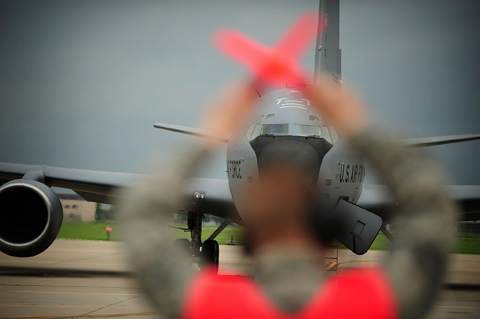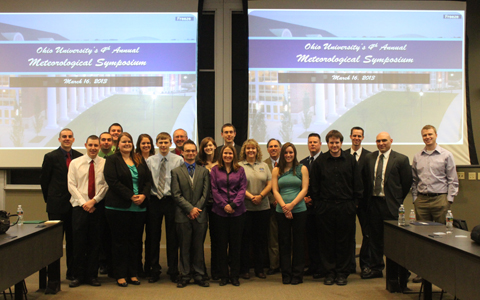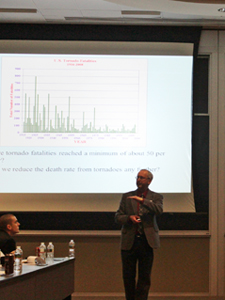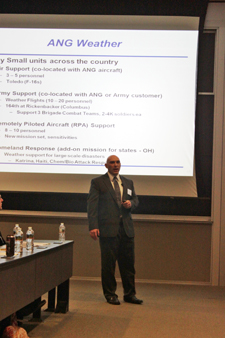Get in the car during a tornado? Ride out Hurricane Katrina? Move an entire squadron of KC135 Stratotankers because of a weather forecast? For meteorologists, weather isn’t just a natural phenomenon. It’s a passion for protecting people—and sometimes it’s even a personal experience at ground zero.
Speakers told their up-close and personal experiences and shared career advice at the 2013 Meteorological Symposium sponsored by the student chapter of the American Meteorological Society, whose students are studying meteorology in the Geography Department at Ohio University.
Get in Your Car, Not the Ditch?
Dr. Thomas Schmidlin, concerned about deaths of mobile home residents during tornadoes, wanted to know if getting into a car was safer than staying inside a mobile home. His premise was that folks might be persuaded to get into a car, but few people really want to crawl into a ditch during a thunderstorm.
He began studying the effect of wind speed on vehicles more than a decade ago, but it took years of scientific studies to influence officials to change tornado guidelines. Now mobile home residents are advised to get out of their homes and into vehicles, which give them the options of driving to a shelter or driving out of the path of a tornado. Schmidlin is a Kent State Professor of Geography.
“Our research focus at Kent State has been on reducing fatalities from tornadoes and progress appeared possible on several fronts. However, the 2011 tornado season brought 59 killer tornadoes across 14 states and 552 deaths, the largest toll since 1936. The tornado death rate was 1.75 per million up to 1925 and declined to 0.15 in the 1990s (Brooks and Doswell 2002). But in 2011 it was 1.75 per million, back to 1920. How can we explain the deadly 2011 season? Possibilities are explored and a new dilemma appears – permanent homes and violent tornadoes,” he said in his abstract.
Sometimes, meteorologists actually find themselves at ground zero in nature’s fury—experiencing the power of the storms they have spent their lives studying.
Direct Hit: Hurricane Katrina
Scott Lutz ’95 had taken his family to Keesler Air Force Base in Biloxi, a city on the Mississippi Gulf coast, for a weather officer training course in 2005, only to find Hurricane Katrina bearing down on them. With plenty of warning time available, he sent his family to Florida to stay with friends.
Lutz was called to report to the base early Saturday morning—48 hours ahead of a forecasted direct hit by the hurricane. As Katrina arrived, Lutz and base personnel would spend 60 hours inside a shelter. Their “release” didn’t happen until Friday.
They emerged to find portions of the base flooded and buildings destroyed. While national media attention focused mainly on New Orleans, the coastline and economy of Mississippi changed overnight. Bridges, roadways and homes were swept away. Gambling barges and businesses were turned to rubble.
Lutz earned a B.S. in Geography from Ohio University in 1995. Following graduation, he was accepted to the Air Force’s Officers Training School at Maxwell Air Force Base in Montgomery, AL, receiving his commission in March 1996 as a Communications Officer. He then served on Active Duty for nearly 10 years in various assignments at Keesler AFB, Mississippi, Wright-Patterson AFB, Ohio, and Royal Air Force (RAF) Mildenhall, England. He is currently the Meteorological Services Government Representative for the 88th Operations Support Squadron at Wright Patterson Air Force Base in Ohio. His civil service position oversees meteorological services including the operation of the base weather station and the delivery of mission, airfield, and staff weather services. That includes weather information related to timing, planning and executing more than 1,000 flying missions per year.
In addition to his civil service, Mr. Lutz is also a Lieutenant Colonel (part-time) in the Ohio Air National Guard where he serves as the Commander of the 164th Weather Flight at Rickenbacker Air National Guard Base in Columbus. As Commander, he leads a flight of 11 personnel responsible for providing battlefield weather services for Active Duty and National Guard Army units.

A McConnell Airman marshals a KC-135 Stratotanker April 14, 2012, McConnell Air Force Base, Kansas. A decision to relocate 16 aircraft based on a weather forecast saved the fleet of mission-critical refueling aircraft. (U.S. Air Force photo/ Senior Airman Courtney Witt)
Direct Hit: Saving McConnell’s KC135 Stratotankers
Chief Master Sergeant Charles R. Hoffman is Air Force Material Command functional manager for weather at Wright-Patterson Air Force Base in Ohio. But in April 2012, he was at McConnell Air Force Base putting his weather expertise on the line.
McConnell is a super tanker base for the KC-135 Stratotanker fleet of refueling planes. And Hoffman was advising the base command to take a very unusual step—evacuate the tankers based on the probability of a tornado.
Hoffman’s recommendation, based on his study of the developing weather, was made well ahead of the approaching storm. The KC-135s took off for Grand Forks AFB in good weather, and the base put out a public announcement:
“Once hearing the potential of strong hail, the universal decision was made to evacuate 16 aircraft and place 10 in hangars,” said Capt. Eric Waldo, 22nd Command Post chief. “If the planes are left out, the damage will be costly to fix and the time lost would hinder the mission.”
With the majority of aircraft off-station supporting worldwide missions or out for maintenance, it’s even more important to protect the 26 aircraft at McConnell. Each aircraft costs approximately $40 million dollars, and they are in high-demand to provide air refueling support around the world in a moment’s notice, said Senior Airman Michael Heasley, 22nd Aircraft Maintenance Squadron crew chief.
Once senior leaders elected to relocate the aircraft, base operations put the plans in motion and crews worked quickly to evacuate.
“I have never done an evacuation before,” said Heasley, “but, I have been on three deployments, and we can go anywhere in the world within 24 hours.”
The evacuation showcased the base’s ability to quickly move its aircraft. Heasley said when it comes to national security, McConnell’s mission comes first.
Even if the anticipated weather bypasses McConnell and the Wichita area, hail damage can put a dent in the McConnell mission. That threat alone is worth moving the aircraft, he said.
The weather did not bypass McConnell. Instead, a powerful tornado struck the base, damaging hangars and buildings—but not the mission-critical irreplaceable Stratotankers, each worth an estimated $40 million. Watch a news report.
“Air Force weather is much more than Terminal Aerodrome Forecasts and weather watches warnings and advisories,” Hoffman said in his abstract. “Air Force weather forecasts drive business decisions. On 14 April, 2012, McConnell AFB leadership evacuated all aircraft from the McConnell flight line to a safe location, Grand Forks, North Dakota. This evacuation, on a severe weather forecast, was the first of its kind at McConnell.”
While the planes evacuated, Hoffman did not, and he gave attendees a first-hand account of riding out an EF2-EF3 tornado.
A Student-Run Symposium
“As Vice President, I was so pleased to see some of the younger members step up and become leaders in preparation for the 4th Annual Symposium this year. It was their hard work that really made the event seamless,” said Michele Waite, Vice President of the Ohio University student chapter of the American Meteorological Society. View photos from the symposium.
“Putting the symposium together was a blast; doing my part to make sure that the whole day went seamless was a big task, but in the end, worth all the work that everyone put into the gathering,” said Alex Vorst, Symposium Logistics Chair.
“One of our main goals as a chapter is to develop strong, well-rounded leaders in the field of meteorology. Our ‘final exam’ for this goal is our annual symposium. We cannot execute a successful event unless everyone involved applies 100 percent effort and makes good decisions. After hearing so many of our audience compliment us on a job well done, I say we have passed our final exam,” said Tom McKenzie, President.
Also making presentations at the symposium:
- Dr. William Lapenta, Acting Director of Environmental Modeling Center at the National Centers for Environmental Prediction/NOAA/NWS: The Transition of Research to Operations: Perspectives from both sides of the “Valley of Death.”
- Mr. Trent Magill, WEWS News Channel 5, Cleveland, Ohio. The Changing role of Broadcast Meteorology.
- Ms. Ashley V. Novak, National Weather Service, Wilmington, Ohio: A Multi-Perspective Review of the June 29, 2012 Derecho.
- Mr. Matthew R. Alto, AccuWeather, State College, Pennsylvania: A Look at the Private Weather Enterprise.






















Comments